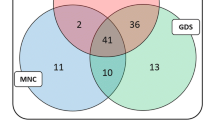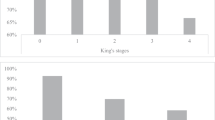Abstract
Background
The Frontal Assessment Battery (FAB) is a reliable and valid bedside tool for testing executive function in dementia. Given the increasing interest in utility of FAB as a screening tool in early cognitive impairment (ECI), there is a surprising lack of studies evaluating its psychometric property and factor structure, nor the influence of factors such as age, education and gender, in ECI.
Objectives
This study aims to investigate the psychometric properties and factor structure of FAB in older adults with ECI, as well as the influence of age, gender and education.
Design, Setting and Participants
This is a retrospective, observational cross-sectional study with 300 community dwelling, predominantly Chinese older adults (14 normal, 130 mild cognitive impairment (MCI), and 156 mild dementia) who presented to Memory Clinic from January 2011 to December 2013.
Measurements and Analysis
We collected data on demographic, cognitive, functional and behavioral evaluation. To examine the psychometric properties of FAB, we examined the concurrent, convergent, and discriminant validity; internal consistency by Cronbach’s alpha; and factor structure by exploratory factor analysis. The influence of age, education and gender was examined using unadjusted and adjusted correlational analyses with CDR-SOB. We performed analysis for the whole group and for MCI subgroup.
Results
FAB total score decreases significantly from normal to dementia group attesting to concurrent validity. It correlated significantly with digit span backwards and Chinese Mini Mental State Examination (r=0.38 and 0.47 respectively, p<0.01) and poorly with Neuropsychiatric Inventory-Questionnaire and depression (r=0.004 and −0.02 respectively), supporting its convergent and discriminant validity. Factor analysis yielded a single-factor solution for FAB with fair Internal consistency (alpha=0.610). FAB is relatively unaffected by age, gender and education level. These good psychometric properties extend to MCI, albeit with greater influence by education level. FAB items of conceptualization and mental flexibility have good discriminatory ability between MCI and normal subjects.
Conclusion
FAB has good concurrent, convergent and discriminant validity with fair internal consistency in ECI that is premised on a one-factor structure. It is relatively unaffected by age, gender or education. Taken together, FAB is a useful bedside screening tool for executive function in ECI.
Similar content being viewed by others
References
Dubois B, Slachesvsky A, Litvan I, et al: The FAB. A Frontal Assessment Battery at bedside. Neurology 2000; 55: 1621–1626.
Guedj E, Allali G, Goetz C, et al. 2008. Frontal assessment battery is a marker of dorsolateral and medial frontal functions: a SPECT study in frontotemporal dementia. J Neurol Sci 273(1–2): 84–87.
Lee JH, Byun MS, Sohn BK, et al. 2015. Functional neuroanatomical correlates of the frontal assessment battery performance in Alzheimer disease: a FDG-PET study. J Geriatr Psychiatry Neurol 28(3): 184–192.
Castiglioni S, Pelati O, Zuffi M, et al. 2006. The frontal assessment battery does not differentiate frontotemporal dementia from Alzheimer’s disease. Dement Geriatr Cogn Disord 22(2): 125–131.
Nagata T, Shinagawa S, Ochiai Y, et al. 2011. Association between executive dysfunction and hippocampal volume in Alzheimer’s disease. Int Psychogeriatr 23(5): 764–771.
Matsui H, Udaka F, Miyoshi T, et al. 2006. Frontal assessment battery and brain perfusion image in Parkinson’s disease. J Geriatr Psychiatry Neurol 19(1): 41–45.
Slachevsky A, Villalpando JM, Sarazin M, et al. 2004. Frontal assessment battery and differential diagnosis of frontotemporal dementia and Alzheimer disease. Arch Neurol 61(7): 1104–1107.
Lipton AM, Ohman KA, Womack KB, et al. 2005. Subscores of the FAB differentiate frontotemporal lobar degeneration from AD. Neurology 65(5): 726–731.
Paviour DC, Winterburn D, Simmonds S, et al. 2005. Can the frontal assessment battery (FAB) differentiate bradykinetic rigid syndromes? relation of the FAB to formal neuropsychological testing. Neurocase 11(4): 274–282.
Oguro H, Yamaguchi S, Abe S, et al. 2006. Differentiating Alzheimer’s disease from subcortical vascular dementia with the FAB test. J Neurol 253(11): 1490–1494.
Kawai Y, Miura R, Tsujimoto M, et al. 2013. Neuropsychological differentiation between Alzheimer’s disease and dementia with Lewy bodies in a memory clinic. Psychogeriatrics 13(3): 157–163.
Hurtado-Pomares M, Carmen Terol-Cantero M, Sánchez-Pérez A, Peral-Gómez P, Valera-Gran D, Navarrete-Muñoz EM. The frontal assessment battery in clinical practice: a systematic review. International journal of geriatric psychiatry. 2018 Feb;33(2):237–51.
Moreira HS, Costa AS, Castro SL, Lima CF, Vicente SG. Assessing Executive Dysfunction in Neurodegenerative Disorders: A Critical Review of Brief Neuropsychological Tools. Frontiers in aging neuroscience. 2017 Nov 9;9:369.
Chong MS, Lim WS, Chan SP, Feng L, Niti M, Yap P, Yeo D, Ng TP. Diagnostic performance of the Chinese Frontal Assessment Battery in early cognitive impairment in an Asian population. Dementia and geriatric cognitive disorders. 2010;30(6):525–32
Kim JW, Lee DY, Seo EH, Sohn BK, Park SY, Choo IL, Youn JC, Jhoo JH, Kim KW, Woo JI. Improvement of dementia screening accuracy of mini-mental state examination by education-adjustment and supplementation of frontal assessment battery performance. Journal of Korean medical science. 2013 Oct 1;28(10):1522–8.
Hsu YH, Huang CF, Lo CP, Wang TL, Yang CC, Tu MC. Frontal assessment battery as a useful tool to differentiate mild cognitive impairment due to subcortical ischemic vascular disease from Alzheimer disease. Dementia and geriatric cognitive disorders. 2016;42(5–6):331–41.
Hanyu H, Sato T, Takasaki A, Akai T, Iwamoto T. Frontal lobe dysfunctions in subjects with mild cognitive impairment. Journal of neurology. 2009 Sep 1;256(9):1570–1.
Zhang Y, Han B, Verhaeghen P, Nilsson LG. Executive functioning in older adults with mild cognitive impairment: MCI has effects on planning, but not on inhibition. Aging, Neuropsychology, and Cognition. 2007 Nov 14;14(6):557–70.
Wang TL, Hung YH, Yang CC. Psychometric properties of the Taiwanese (traditional Chinese) version of the Frontal Assessment Battery: a preliminary study. Applied Neuropsychology: Adult. 2016 Jan 2;23(1):11–20.
Norman, D. A., & Shallice, T. (1986). Attention to action: Willed and automatic control of behavior. In R. J. Davidson, G. E. Schwartz, & D. Shapiro (Eds.), Consciousness and self-regulation (pp. 1–18). New York, NY: Plenum.
L Tay, WS Lim, M Chan Mark, N Ali, S Mahanum, P Chew, J Lim, MS Chong (2015). The new DSM-5 neurocognitive disorders criteria and its impact on prevalence of mild cognitive impairment and dementia in a memory clinic setting. Am J Geriatr Psychiatry, 23(8):768–779.
Chan M, Tay L, Chong MS. Amnestic mild cognitive impairment and early Alzheimer’s disease in an Asian memory clinic-evidence for a clinical spectrum. Dement Geriatr Cogn Dis Extra (2011)
WS Lim, JJ Chin, CK Lam, PPJ Lim, S Sahadevan (2005). Clinical Dementia Rating: Experience of a multi-racial Asian Population. Alzheimer Disease and Associated Disorders, 19(3):135–142.
WS Lim, MS Chong, Sahadevan S (2007). Utility of the Clinical Dementia Rating in Asian populations. Clinical Medicine and Research, 5(1): 61–70.
Collin C, Wade DT, Davies S, Horne V. The Barthel ADL Index: a reliability study. International disability studies. 1988 Jan 1;10(2):61–3.
Lawton MP, Brody EM. Assessment of older people: self-maintaining and instrumental activities of daily living. The gerontologist. 1969 Oct 1;9(3_Part_1):179–86.
Sahadevan S, Tan NJ, Tan T, Tan S: Cognitive testing of elderly Chinese people in Singapore: influence of education and age on normative scores. Age Ageing 1997; 26: 481–486
American Psychiatric Associatin. Diagnostic and Statistical Manual of Mental Disorder, Fourth Edition. Washington DC; American Psychiatric Association; 1994.
Kaufer DI, Cummings JL, Ketchel P, Smith V, MacMillan A, Shelley T, Lopez OL, DeKosky ST. Validation of the NPI-Q, a brief clinical form of the Neuropsychiatric Inventory. The Journal of neuropsychiatry and clinical neurosciences. 2000 May;12(2):233–9.
Sahadevan S, Lim JP, Tan NJ, Chan SP: Psychometric identification of early Alzheimer disease in an elderly Chinese population with differing educational levels. Alzheimer Dis Assoc Disord 2002; 16: 65–72.
Horn, J.L. (1965). A rationale and test for the number of factors in factor analysis. Psychometrika, 30, 179–185.
Osborne JW, Costello AB, Kellow JT. Best practices in exploratory factor analysis. Best practices in quantitative methods. 2008:86–99.
Kim TH, Huh Y, Choe JY, Jeong JW, Park JH, Lee SB, Lee JJ, Jhoo JH, Lee DY, Woo JI, Kim KW. Korean version of frontal assessment battery: psychometric properties and normative data. Dementia and geriatric cognitive disorders. 2010;29(4):363–70.
Mok VCT, Wong A, Yim P, et al: The validity and reliability of Chinese Frontal Assessment Battery in evaluating executive dysfunction among Chinese patients with small subcortical infarct. Alz Dis Assoc Disord 2004; 18: 68–74.
Ladera V, Sargento P, Perea V, Faria M, Garcia R. Sensitivity and specificity of Frontal Assessment Battery in newly diagnosed and untreated obstructive sleep apnea patients. Sleep medicine. 2018 Feb 1;42:1–6.
LA Munang, M Chan, WS Lim (2010). Clock Drawing Test: Diagnostic performance using a pre-drawn circle in early dementia. Asian J Gerontol Geriatr 2010; 5: 54–6.
Acknowledgements
We would like to thank the doctors and nurse clinicians of the Cognition and Memory Disorders Service, Department of Geriatric Medicine, Tan Tock Seng Hospital, and research assistants from the Institute of Geriatrics and Active Aging, Tan Tock Seng Hospital, for their substantial contribution to data acquisition and other aspects of the study.
Funding
Funding: None. All the authors have read the papers, fulfilled the criteria for authorship and have agreed to be listed as authors.
Author information
Authors and Affiliations
Corresponding author
Ethics declarations
Conflict of interests: None.
Ethical Standards: This study was approved by the National Healthcare Group Domain Specific Review Board.
Rights and permissions
About this article
Cite this article
Goh, W.Y., Chan, D., Ali, N.B. et al. Frontal Assessment Battery in Early Cognitive Impairment: Psychometric Property and Factor Structure. J Nutr Health Aging 23, 966–972 (2019). https://doi.org/10.1007/s12603-019-1248-0
Received:
Accepted:
Published:
Issue Date:
DOI: https://doi.org/10.1007/s12603-019-1248-0




